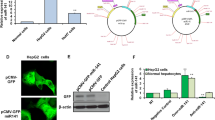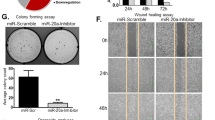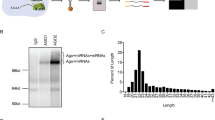Abstract
Aim:
MiR-506 is a miRNA involved in carcinogenesis of several kinds of cancer. In this study, we explored whether miR-506 played a critical role in hepatocellular carcinoma (HCC).
Methods:
Twenty HCC and adjacent normal liver tissue samples were collected. Human hepatoma cell lines HepG2 and H7402 were used for in vitro studies. The expression of miR-506 and transcriptional co-activator YAP was examined using qRT-PCR. Western blot analysis was used to measure the expression of YAP and its target genes. Luciferase reporter gene assay was used to identify YAP as a target gene of miR-506. MTT and EdU assays were carried out for functional analysis.
Results:
The expression of miR-506 was significantly lower in HCC than in adjacent normal liver tissues. Bioinformatics analysis revealed that YAP mRNA might be one of the targets of miR-506, and miR-506 in HCC tissues was found to be negatively correlated with YAP (r=−0.605). In both HepG2 and H7402 cells, miR-506 dose-dependently down-regulated YAP and its target genes c-Myc and the connective tissue growth factor (CTGF). Luciferase reporter gene assays demonstrated that miR-506 targeted the wild type 3′UTR of YAP mRNA, but not a 3′UTR with a mutant seed site. Furthermore, miR-506 significantly inhibited the proliferation of HepG2 and H7402 cells, while anti-miR-506 enhanced the cell proliferation, which was blocked by YAP siRNA.
Conclusion:
MiR-506 suppresses the proliferation of hepatoma cells by targeting YAP mRNA.
Similar content being viewed by others
Log in or create a free account to read this content
Gain free access to this article, as well as selected content from this journal and more on nature.com
or
References
Gregory RI, Chendrimada TP, Cooch N, Shiekhattar R . Human RISC couples microRNA biogenesis and posttranscriptional gene silencing. Cell 2005; 123: 631–40.
Sassen S, Miska EA, Caldas C . MicroRNA: implications for cancer. Virchows Arch 2008; 452: 1–10.
Gregory PA, Bert AG, Paterson EL, Barry SC, Tsykin A, Farshid G, et al. The miR-200 family and miR-205 regulate epithelial to mesenchymal transition by targeting ZEB1 and SIP1. Nat Cell Biol 2008; 10: 593–601.
Callegari E, Elamin BK, Sabbioni S, Gramantieri L, Negrini M . Role of microRNAs in hepatocellular carcinoma: a clinical perspective. Onco Targets Ther 2013; 6: 1167–78.
Lu R, Ji Z, Li X, Zhai Q, Zhao C, Jiang Z, et al. miR-145 functions as tumor suppressor and targets two oncogenes, ANGPT2 and NEDD9, in renal cell carcinoma. J Cancer Res Clin Oncol 2014; 140: 387–97.
Zheng SG, Xu HX, Liu LN . Management of hepatocellular carcinoma: The role of contrast-enhanced ultrasound. World J Radiol 2014; 6: 7–14.
Farazi PA, DePinho RA . Hepatocellular carcinoma pathogenesis: from genes to environment. Nat Rev Cancer 2006; 6: 674–87.
Zhang S, Shan C, Kong G, Du Y, Ye L, Zhang X . MicroRNA-520e suppresses growth of hepatoma cells by targeting the NF-kappaB-inducing kinase (NIK). Oncogene 2012; 31: 3607–20.
Zhang T, Zhang J, Cui M, Liu F, You X, Du Y, et al. Hepatitis B virus X protein inhibits tumor suppressor miR-205 through inducing hypermethylation of miR-205 promoter to enhance carcinogenesis. Neoplasia 2013; 15: 1282–91.
Yang D, Sun Y, Hu L, Zheng H, Ji P, Pecot CV, et al. Integrated analyses identify a master microRNA regulatory network for the mesenchymal subtype in serous ovarian cancer. Cancer Cell 2013; 23: 186–99.
Arora H, Qureshi R, Park WY . miR-506 regulates epithelial mesenchymal transition in breast cancer cell lines. PLoS One 2013; 8: e64273.
Yin M, Ren X, Zhang X, Luo Y, Wang G, Huang K, et al. Selective killing of lung cancer cells by miRNA-506 molecule through inhibiting NF-kappaB p65 to evoke reactive oxygen species generation and p53 activation. Oncogene 2014. doi: 10.1038/onc.2013.597.
Xiao W, Wang J, Ou C, Zhang Y, Ma L, Weng W, et al. Mutual interaction between YAP and c-Myc is critical for carcinogenesis in liver cancer. Biochem Biophys Res Commun 2013; 439: 167–72.
Tschaharganeh DF, Chen X, Latzko P, Malz M, Gaida MM, Felix K, et al. Yes-associated protein up-regulates Jagged-1 and activates the Notch pathway in human hepatocellular carcinoma. Gastroenterology 2013; 144: 1530–42.
Bai N, Zhang C, Liang N, Zhang Z, Chang A, Yin J, et al. Yes-associated protein (YAP) increases chemosensitivity of hepatocellular carcinoma cells by modulation of p53. Cancer Biol Ther 2013; 14: 511–20.
Camargo FD, Gokhale S, Johnnidis JB, Fu D, Bell GW, Jaenisch R, et al. YAP1 increases organ size and expands undifferentiated progenitor cells. Curr Biol 2007; 17: 2054–60.
Lamar JM, Stern P, Liu H, Schindler JW, Jiang ZG, Hynes RO . The Hippo pathway target, YAP, promotes metastasis through its TEAD-interaction domain. Proc Natl Acad Sci U S A 2012; 109: E2441–50.
Yu FX, Guan KL . The Hippo pathway: regulators and regulations. Genes Dev 2013; 27: 355–71.
Dong J, Feldmann G, Huang J, Wu S, Zhang N, Comerford SA, et al. Elucidation of a universal size-control mechanism in Drosophila and mammals. Cell 2007; 130: 1120–33.
Zhang T, Zhang J, You X, Liu Q, Du Y, Gao Y, et al. Hepatitis B virus X protein modulates oncogene Yes-associated protein by CREB to promote growth of hepatoma cells. Hepatology 2012; 56: 2051–9.
Shan C, Xu F, Zhang S, You J, You X, Qiu L, et al. Hepatitis B virus X protein promotes liver cell proliferation via a positive cascade loop involving arachidonic acid metabolism and p-ERK1/2. Cell Res 2010; 20: 563–75.
Liu-Chittenden Y, Huang B, Shim JS, Chen Q, Lee SJ, Anders RA, et al. Genetic and pharmacological disruption of the TEAD-YAP complex suppresses the oncogenic activity of YAP. Genes Dev 2012; 26: 1300–5.
Wang J, Park JS, Wei Y, Rajurkar M, Cotton JL, Fan Q, et al. TRIB2 acts downstream of Wnt/TCF in liver cancer cells to regulate YAP and C/EBPalpha function. Mol Cell 2013; 51: 211–25.
You X, Liu F, Zhang T, Li Y, Ye L, Zhang X . Hepatitis B virus X protein upregulates oncogene Rab18 to result in the dysregulation of lipogenesis and proliferation of hepatoma cells. Carcinogenesis 2013; 34: 1644–52.
You X, Liu F, Zhang T, Lv N, Liu Q, Shan C, et al. Hepatitis B virus X protein upregulates Lin28A/Lin28B through Sp-1/c-Myc to enhance the proliferation of hepatoma cells. Oncogene 2014; 33: 449–60.
Xu B, Li SH, Zheng R, Gao SB, Ding LH, Yin ZY, et al. Menin promotes hepatocellular carcinogenesis and epigenetically up-regulates Yap1 transcription. Proc Natl Acad Sci U S A 2013; 110: 17480–5.
Lau AN, Curtis SJ, Fillmore CM, Rowbotham SP, Mohseni M, Wagner DE, et al. Tumor-propagating cells and Yap/Taz activity contribute to lung tumor progression and metastasis. EMBO J 2014; 33: 468–81.
Urtasun R, Latasa MU, Demartis MI, Balzani S, Goni S, Garcia-Irigoyen O, et al. Connective tissue growth factor autocriny in human hepatocellular carcinoma: oncogenic role and regulation by epidermal growth factor receptor/yes-associated protein-mediated activation. Hepatology 2011; 54: 2149–58.
Xu MZ, Yao TJ, Lee NP, Ng IO, Chan YT, Zender L, et al. Yes-associated protein is an independent prognostic marker in hepatocellular carcinoma. Cancer 2009; 115: 4576–85.
Li L, Wang J, Zhang Y, Zhang Y, Ma L, Weng W, et al. MEK1 promotes YAP and their interaction is critical for tumorigenesis in liver cancer. FEBS Lett 2013; 587: 3921–7.
Song T, Zhang X, Zhang L, Dong J, Cai W, Gao J, et al. miR-708 promotes the development of bladder carcinoma via direct repression of Caspase-2. J Cancer Res Clin Oncol 2013; 139: 1189–98.
Cao Z, Yoon JH, Nam SW, Lee JY, Park WS . PDCD4 expression inversely correlated with miR-21 levels in gastric cancers. J Cancer Res Clin Oncol 2012; 138: 611–9.
Wang C, Gao C, Zhuang JL, Ding C, Wang Y . A combined approach identifies three mRNAs that are down-regulated by microRNA-29b and promote invasion ability in the breast cancer cell line MCF-7. J Cancer Res Clin Oncol 2012; 138: 2127–36.
Markova SM, Kroetz DL . ABCC4 is regulated by microRNA-124a and microRNA-506. Biochem Pharmacol 2014; 87: 515–22.
Tong JL, Zhang CP, Nie F, Xu XT, Zhu MM, Xiao SD, et al. MicroRNA 506 regulates expression of PPAR alpha in hydroxycamptothecin-resistant human colon cancer cells. FEBS Lett 2011; 585: 3560–8.
Wu GG, Li WH, He WG, Jiang N, Zhang GX, Chen W, et al. Mir-184 post-transcriptionally regulates SOX7 expression and promotes cell proliferation in human hepatocellular carcinoma. PLoS One 2014; 9: e88796.
Cui M, Wang Y, Sun B, Xiao Z, Ye L, Zhang X . MiR-205 modulates abnormal lipid metabolism of hepatoma cells via targeting acyl-CoA synthetase long-chain family member 1 (ACSL1) mRNA. Biochem Biophys Res Commun 2014; 444: 270–5.
Cui M, Xiao Z, Sun B, Wang Y, Zheng M, Ye L, et al. Involvement of cholesterol in hepatitis B virus X protein-induced abnormal lipid metabolism of hepatoma cells via up-regulating miR-205-targeted ACSL4. Biochem Biophys Res Commun 2014; 445: 651–5.
Acknowledgements
This work was supported by grants from the National Natural Science Foundation of China (No 81372186 and 81272218) and Support Program of National Science and Technology of China (No 2012BAI23B08).
Author information
Authors and Affiliations
Corresponding author
Additional information
Supplementary information is available at Acta Pharmacologica Sinica's website.
Supplementary information
Supplementary Table 1
Clinical characteristics of HCC tissue samples. (DOC 67 kb)
Rights and permissions
About this article
Cite this article
Wang, Y., Cui, M., Sun, Bd. et al. MiR-506 suppresses proliferation of hepatoma cells through targeting YAP mRNA 3′UTR. Acta Pharmacol Sin 35, 1207–1214 (2014). https://doi.org/10.1038/aps.2014.59
Received:
Accepted:
Published:
Issue date:
DOI: https://doi.org/10.1038/aps.2014.59
Keywords
This article is cited by
-
MicroRNA dysregulation interplay with childhood abdominal tumors
Cancer and Metastasis Reviews (2019)
-
miR-550a-3-5p acts as a tumor suppressor and reverses BRAF inhibitor resistance through the direct targeting of YAP
Cell Death & Disease (2018)
-
miR-511 promotes the proliferation of human hepatoma cells by targeting the 3′UTR of B cell translocation gene 1 (BTG1) mRNA
Acta Pharmacologica Sinica (2017)
-
miR-199a-3p inhibits cell proliferation and induces apoptosis by targeting YAP1, suppressing Jagged1-Notch signaling in human hepatocellular carcinoma
Journal of Biomedical Science (2016)
-
MicroRNA-506 is up-regulated in the development of pancreatic ductal adenocarcinoma and is associated with attenuated disease progression
Chinese Journal of Cancer (2016)



